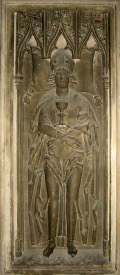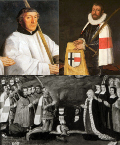Function: portraits as memoria?
What exactly was to be commemorated by the portraits of Jerusalem pilgrims? The answer differs for each object. The texts that are included on many objects can provide clues for answering this question.
First and foremost, the pilgrimage itself was commemorated. Besides that, in many cases there is a clear and direct link with the commemoration of the dead and care for the souls. Memorial objects, for instance, were made primarily for the commemoration of the deceased. Some single portraits may have been made for this purpose as well, like the portrait of Eliard Cromme from Kampen. On confraternity portraits, this function becomes apparent too: the Haarlem group portrait, for example, starts with a list of deceased members, and mentions the year of death of almost all depicted brothers. It is known that members could be buried in some confraternity chapels.
This is not the case with all confraternity portraits, however: in Utrecht, for example, dates of death or requests to pray for one's soul are hardly mentioned at all. Louise van Tongerloo has therefore argued that commemoration of the dead was less important in these portraits. Only a small part of the members of the confraternity were portrayed. Besides, it is probable that no burials took place in the Utrecht Jerusalem chapel. Some single copies of portraits of Utrecht Jerusalem pilgrims may have been intended to be placed near a grave, though.1 By contrast, the Utrecht portraits were probably intended as a communal commemoration of the pilgrimage, or to display social status.
Graves and individual portraits often show that pilgrims had made other pilgrimages as well. References to these pilgrimages are very rare on the confraternity portraits, however.2 This is also caused by a difference in function: the memory of the collective pilgrimage was paramount to the confraternity portraits. Tomb stones and individual portraits, however, were more personal, and all the performed acts of penitence and social prestige could be displayed on them. Individual objects in these mediums can be very divergent, though: the graves of Jan van Scorel and Bernhard von Breydenbach, both famous Jerusalem pilgrims, show no traces of the pilgrimage at all, as far as we know.
Portraits of Jerusalem pilgrims could be intended as social or political levers as well. The portrait series of the land commanders of the Teutonic Order in Utrecht, for example, can be seen in this sense. The series shows the long history of the order in Utrecht, which brings along an expectation or a wish to continue this tradition in the future. Jacob Taets van Amerongen, the probable founder of the series and the only one depicted as Jerusalem pilgrim, tried to revive the religious character of the order, and as such we can possibly see the palm branch in his hand as referring to the origins of the order, during the Crusades.3 He was possibly inspired by the portrait of his grand uncle Anthonis, who is depicted in the portrait series of the Utrecht confraternity.
The Jerusalem pilgrimage could thus become a family tradition. In a considerable number of families multiple members were depicted as Jerusalem pilgrims, some even on the same object. This even could be the reason why so many portraits have survived. Later family members must have taken an interest in their illustruous forebears, and ensured their portraits survived the Iconoclasm.
Previous: Portraits of Jerusalem pilgrims
Next: Attributes and insignia
- Tongerloo, Louise van, 'Grablegung und Totengedenken bei Pilgerbruderschaften in Utrecht, mit einer Neuinterpretation von Scorels und Mors Bildnisreihen von Jerusalemfahrern,' in Truus van Bueren and Andrea van Leerdam, Care for the Here and Hereafter: Memoria, Art and Ritual in the Middle Ages (Turnhout 2005), pp. 221-247, p. 233.
- In one case another pilgrimage is mentioned in the accompanying text: With Anthonis Taets van Amerongen on the group portrait with two members of the Utrecht confraternity of Jerusalem pilgrims.
- Meeuwissen, Daantje, Gekoesterde traditie. De portretreeks met de landcommandeurs van de Utrechtse Balije van de Ridderlijke Duitsche Orde (Hilversum 2011).




